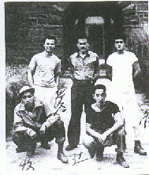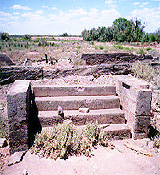
The Japanese inmates at the Leupp Penal Colony. Harry
Ueno in the black shirt sitting in the lower right-hand corner
wrote articles and books about his ordeal. This photograph
was taken by a visitor from Lowell Observatory.
|

The only remnants of the internment camp
are the broken foundations and steps.
|
In 1942, the abandoned BIA buildings at Old Leupp were renovated to be used a the Leupp Penal
Colony, a holding prison for Japanese inmates regarded as "troublemakers." During World War II, all
people of Japanese heritage were rounded up and shipped off to concentration camps, most of which were
located on the remote Indian Reservations in the western part of the United States. Those Japanese males
who questioned the activities of the War Relocation Authority (WRA) were arrested and deported without
due process, to one of the two penal colonies: Leupp Camp in Leupp, Arizona and Moab Camp in Moab,
Utah. According to government records retrieved from the National Archives in Washington, D.C. by Dr.
Louise Lockard and her three associates, the Leupp Penal Colony opened its doors in late February 1943
and closed it in December 1943 to accommodate a total of 80 Japanese males. Navajo eyewitness
accounts indicate the inmates were kept behind highly guarded fenced-in facility complete with four
watchtowers and 250-armed guards. Moreover, the Navajo eyewitnesses reported the inmates were
friendly and learned to say "Yá'á'teeh" to greet the Navajos as they went by the camp on their way to the
Old Leupp Trading Post, located just to the south of the prison. This camp is virtually unheard of to majority
of the Navajo people today across the Navajo Reservation.
|

